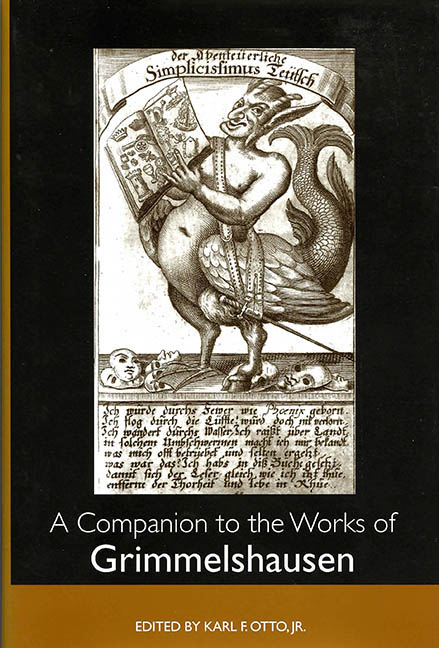Book contents
- Frontmatter
- Contents
- Illustrations
- Acknowledgments
- Chronological List of Grimmelshausen's Works and Their First English Translation
- Introduction
- I Basics
- II Critical Approaches
- Engendering Social Order: From Costume Autobiography to Conversation Games in Grimmelshausen's Simpliciana
- The Poetics of Masquerade: Clothing and the Construction of Social, Religious, and Gender Identity in Grimmelshausen's Simplicissimus
- “To see from these black lines”: The Mise en Livre of the Phoenix Copperplate and Other Grimmelshausen Illustrations
- The Search for Freedom: Grimmelshausen's Simplician Weltanschauung
- Notes on the Contributors
- Index
The Poetics of Masquerade: Clothing and the Construction of Social, Religious, and Gender Identity in Grimmelshausen's Simplicissimus
from II - Critical Approaches
Published online by Cambridge University Press: 27 April 2017
- Frontmatter
- Contents
- Illustrations
- Acknowledgments
- Chronological List of Grimmelshausen's Works and Their First English Translation
- Introduction
- I Basics
- II Critical Approaches
- Engendering Social Order: From Costume Autobiography to Conversation Games in Grimmelshausen's Simpliciana
- The Poetics of Masquerade: Clothing and the Construction of Social, Religious, and Gender Identity in Grimmelshausen's Simplicissimus
- “To see from these black lines”: The Mise en Livre of the Phoenix Copperplate and Other Grimmelshausen Illustrations
- The Search for Freedom: Grimmelshausen's Simplician Weltanschauung
- Notes on the Contributors
- Index
Summary
Grimmelshausen's novelDer Abentheuerliche Simplicissimus Teutsch opens with the following sentence:
Es eröffnet sich zu dieser unserer Zeit (von welcher man glaubt/ daß es die letzte seye) unter geringen Leuten eine Sucht/ in deren die Patienten/ wann sie daran kranck ligen/ und so viel zusammen geraspelt und erschachert haben/ daß sie neben ein paar Hellern im Beutel/ ein närrisches Kleid auff die neue Mode/ mit tausenderley seidenen Banden/ antragen können/ oder sonst etwan durch Glücksfall mannhafft und bekant worden/ gleich Rittermäßige Herren/ und Adeliche Personen von uhraltem Geschlecht/ seyn wollen. (9)
Clothing has meaning. It is, as Entwistle points out in her important monograph in 2000, used to express and shape social realities and to construct individual identities (114). As the quotation indicates, people can use clothing to represent themselves as someone they are not. Social status and identities can be manipulated and even forged through certain uses of dress, if identifiable rigid social norms for dress exist within the group. This gives rise to the possibility of play: clothing can be compliant, deceptive, or outright transgressive. Clothing with its almost unlimited and complex options for signification thus allows the individual to play with identities, but, more important, it gives the narrator a useful tool to play with the identity of his characters, as well as with his own. From this perspective, the opening sentence is designed to send a signal to the reader that clothing and its playful and potentially transgressive use will assume a central role in the novel.
Clothing and bodies in Simplicissimus, I will argue, engage in an unstable relationship that is a major source signaling the protagonist's unstable identity. Simplicissimus's identity is continuously renegotiated throughout the novel through a mechanism described by Munns and Richards in another context: “Bodies and clothes endlessly redefine each other to forge, adapt, adopt — and deny — varieties of selfhood […]” (Munns and Richards, 9).
- Type
- Chapter
- Information
- A Companion to the Works of Grimmelshausen , pp. 299 - 332Publisher: Boydell & BrewerPrint publication year: 2002

